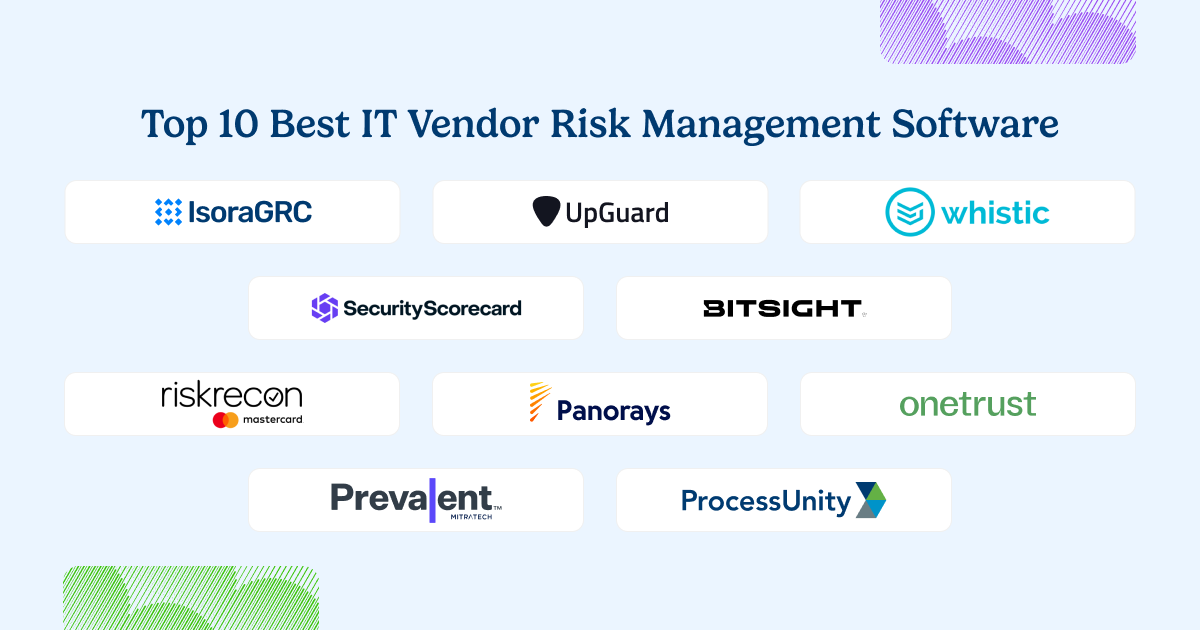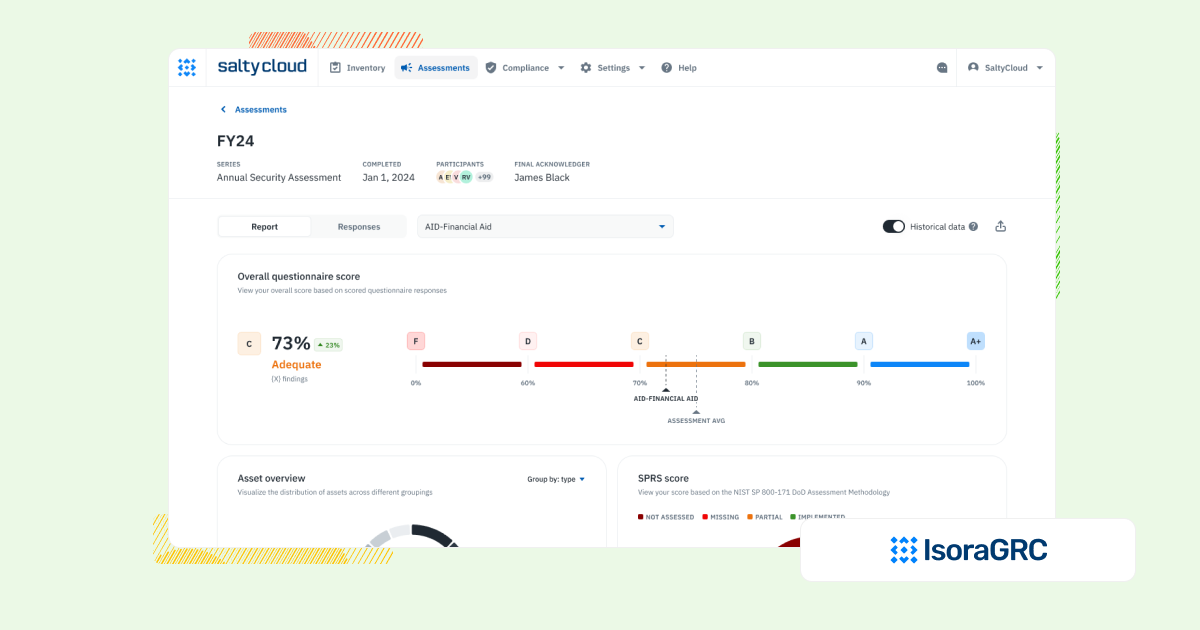
Effectively managing vendor risk is crucial to securing your organization’s data. The best IT vendor risk management software streamlines third-party risk management tasks, such as sending security questionnaires, collecting evidence like SOC 2 certifications, categorizing high-risk and low-risk vendors, and maintaining regulatory compliance. Below, we’ve reviewed the top software solutions that help security teams simplify vendor assessments, monitor security controls, and manage vendor inventories at scale.
What to Look For in Vendor IT Vendor Risk Management Software
| Workflow Capability | Why It Matters in 2025 |
| Assessment Management | Streamlines structured evaluations of vendors using standardized frameworks (HECVAT, CAIQ, SIG) to consistently identify third-party risk. |
| Questionnaire Delivery & Completion | Simplifies the sending, collection, and review of vendor security questionnaires, reducing manual effort and speeding up risk assessments. |
| Inventory Tracking | Centralizes vendor inventories, clearly categorizing high-risk vs. low-risk vendors for better resource allocation and oversight. |
| Risk Register & Exception Management | Enables tracking, documenting, and managing vendor risks and exceptions, ensuring risks are actively monitored and addressed rather than overlooked. |
| Scoring, Reporting & Risk Visualization | Provides vendor risk scorecards, comprehensive reports, and visual insights that guide decision-making and demonstrate compliance to stakeholders. |
| Collaboration & User Experience | Supports internal collaboration between security teams, vendors, data owners, and other stakeholders, ensuring that vendor risk management is streamlined and widely adopted. |
| Implementation & Setup | Allows rapid deployment without significant IT overhead, quickly enabling teams to begin vendor risk assessments and achieve compliance efficiently. |
The Best IT Vendor Risk Management (VRM) Tools in 2025
1. Isora GRC

| Category | Details |
| Best For | Security teams that need to assess, track, and manage third-party vendor risk with a scalable and structured approach to questionnaires, inventories, and regulatory compliance. |
| Overview | Isora GRC is the GRC Assessment Platform™ built specifically for information security teams. It enables organizations to manage third-party vendor risk through structured assessments, automated security questionnaires, centralized vendor inventories, and ongoing risk tracking. Designed to support frameworks like HECVAT, CAIQ, SIG, and more, Isora empowers teams to evaluate vendor risk efficiently and engage internal stakeholders in the process. |
| Strengths | Built for tasks, not checklists
✅ Automates vendor onboarding, security assessments, and exception tracking in one unified experience. Designed for org-wide adoption ✅ WCAG-compliant UI and simplified workflows encourage collaboration across security, vendors, procurement, and data owners. Fast time-to-value ✅ Live in days or weeks, with no-code setup and minimal lift from IT. Flexible by default ✅ Supports custom questionnaires and workflows for different vendor types and risk levels. Scales across vendors and business units ✅ Centralized inventory and scoring for thousands of vendors with role-based access and real-time visibility. |
| Limitations | ⚠️ Not designed for legal, audit, or finance teams seeking one platform for enterprise-wide GRC
⚠️ May be too structured for teams looking to build one-off surveys or lightweight audits without repeatable workflows |
| When to Consider | Ideal for modern security teams that need to scale third-party risk management, move beyond spreadsheets, and drive vendor accountability using structured, collaborative workflows. |
2. UpGuard
| Category | Details |
| Best For | Teams looking for a quick, external view of vendor cybersecurity posture without needing deep internal workflows. |
| Overview | UpGuard specializes in third-party security ratings and breach monitoring. It gives teams visibility into vendor risks from the outside, like leaked credentials or exposed data, but doesn’t provide built-in tools for sending security questionnaires or managing internal review workflows. |
| Strengths | ✅ Strong at identifying vendor risks through automated scans and threat intelligence
✅ Helps prioritize vendors based on external risk signals and exposure alerts |
| Limitations | ⚠️ Lacks internal workflow tools like security questionnaires, vendor onboarding, or exception tracking
⚠️ Not designed for structured vendor risk assessments or collaboration with internal stakeholders |
| When to Consider | If you need fast, external visibility into vendor risks, but can supplement it with another platform for vendor questionnaires, internal scoring, or compliance tracking. |
| Other Comparisons | UpGuard vs Vanta vs Isora GRC
Bitsight vs UpGuard vs Isora GRC UpGuard vs Whistic vs Isora GRC |
3. Whistic
| Category | Details |
| Best For | Teams focused on sharing and reviewing standardized security questionnaires like CAIQ, SIG, and HECVAT. |
| Overview | Whistic is designed for security questionnaire exchange. Vendors can upload responses to common frameworks and share them with multiple customers. While it streamlines review, it doesn’t offer in-depth tracking, scoring, or exception management for internal third-party risk workflows. |
| Strengths | ✅ Simplifies the sharing and reuse of vendor questionnaires (CAIQ, SIG, HECVAT)
✅ Offers a vendor security network that saves time during evaluation |
| Limitations | ⚠️ Doesn’t support internal scoring, vendor onboarding workflows, or risk register tracking
⚠️ Lacks features for customizing assessments or engaging internal procurement and IT stakeholders |
| When to Consider | If you want to speed up the review of vendor questionnaires, but already have tools for managing vendor approvals, risk scoring, or tracking exceptions internally. |
| Other Comparisons | UpGuard vs Whistic vs Isora GRC |
4. SecurityScorecard
| Category | Details |
| Best For | Organizations that want a continuous, outside-in view of vendor cybersecurity health through security ratings. |
| Overview | SecurityScorecard gives companies automated security ratings for vendors by scanning their external digital footprint. It helps identify surface-level risk indicators but doesn’t support internal risk workflows like questionnaires, onboarding, or exception handling. |
| Strengths | ✅ Offers real-time, external risk scoring based on vendor vulnerabilities and threat exposure
✅ Useful for monitoring a large number of vendors continuously |
| Limitations | ⚠️ Doesn’t include internal workflows like sending security questionnaires or managing review processes
⚠️ Limited use for organizations that need collaborative risk reviews or compliance documentation |
| When to Consider | If you need to monitor vendor cybersecurity posture at scale, but can pair it with a structured internal platform for questionnaires, approvals, and vendor lifecycle management. |
| Other Comparisons | Bitsight vs SecurityScorecard vs Isora GRC
RiskRecon vs SecurityScorecard vs Isora GRC |
5. Bitsight
| Category | Details |
| Best For | Security teams that want a simple way to track external risk indicators across a large vendor network. |
| Overview | Bitsight focuses on third-party risk scoring through automated external scans. Like SecurityScorecard, it helps prioritize vendor risk based on security posture, but it doesn’t offer internal tools for completing assessments, sending questionnaires, or managing exceptions. |
| Strengths | ✅ Delivers vendor risk ratings and benchmarking based on real-world threat exposure
✅ Scales easily for monitoring thousands of vendors with minimal manual effort |
| Limitations | ⚠️ No support for internal vendor assessment workflows, documentation, or cross-team collaboration
⚠️ Ratings may not reflect internal security practices or compensating controls shared by vendors |
| When to Consider | If your team needs a broad, automated view of vendor security risk, but you also use a platform like Isora GRC to manage questionnaires, scoring, and vendor approvals internally. |
| Other Comparisons | Bitsight vs UpGuard vs Isora GRC
Bitsight vs SecurityScorecard vs Isora GRC |
6. RiskRecon
| Category | Details |
| Best For | Security teams that want to track vendor risk through automated, external cybersecurity scans. |
| Overview | RiskRecon provides continuous monitoring and security ratings based on publicly observable data. It helps identify high-risk vendors but lacks internal workflows like vendor questionnaires, scoring, or exception tracking needed to manage third-party risk in practice. |
| Strengths | ✅ Automated scoring based on external risk signals like vulnerabilities, misconfigurations, and leaked data
✅ Helps prioritize vendor follow-up with risk tiering and alerts |
| Limitations | ⚠️ No built-in tools for sending or reviewing vendor security questionnaires (e.g., HECVAT, CAIQ, SIG)
⚠️ Not suited for collaborative risk reviews or vendor approval workflows |
| When to Consider | If you want to monitor external vendor risks at scale but rely on another tool to manage internal reviews, vendor communication, and regulatory documentation. |
| Other Comparisons | RiskRecon vs SecurityScorecard vs Isora GRC |
7. Panorays
| Category | Details |
| Best For | Teams looking for a blend of external security scoring and vendor questionnaires in one platform. |
| Overview | Panorays combines automated external risk ratings with the ability to send and manage security questionnaires. It’s more flexible than many rating-only tools but still lacks advanced workflow features like exception tracking, customizable scoring models, or role-based access. |
| Strengths | ✅ Combines security ratings with questionnaire delivery and response tracking
✅ Helps automate vendor evaluations with customizable workflows and risk profiles |
| Limitations | ⚠️ Less flexible than platforms built specifically for internal collaboration and custom workflows
⚠️ Reporting and dashboard tools may feel limited for larger teams or complex review cycles |
| When to Consider | If you want a single platform for both security ratings and questionnaires, but don’t need deep workflow customization or scalable internal tracking across departments. |
| Other Comparisons | Bitsight vs Panorays vs Isora GRC |
8. OneTrust
| Category | Details |
| Best For | Organizations focused on vendor privacy compliance, third-party governance, and regulatory documentation. |
| Overview | OneTrust offers a broad set of tools for managing privacy and third-party risk. While it includes vendor questionnaires and policy tracking, its workflows can be rigid and harder to adapt for fast-moving security teams managing large vendor inventories or custom assessments. |
| Strengths | ✅ Supports vendor privacy compliance and third-party due diligence across regulations like GDPR and CCPA
✅ Offers prebuilt assessments and templates for vendor onboarding and review |
| Limitations | ⚠️ Workflows can feel manual and difficult to customize for different vendor types or risk tiers
⚠️ Not designed specifically for IT and security teams managing structured, repeatable vendor risk workflows |
| When to Consider | If your focus is on privacy and vendor documentation, but you’re okay managing IT-specific risk tracking and scoring in a separate platform like Isora GRC. |
| Other Comparisons | OneTrust vs ServiceNow GRC vs Isora GRC |
9. Prevalent
| Category | Details |
| Best For | Teams that want a complete vendor risk management solution with automation and optional expert support. |
| Overview | Prevalent helps organizations manage third-party risk with tools for vendor onboarding, assessments, monitoring, and follow-up. It also uses AI to speed up risk analysis and offers managed services for teams that want extra help. |
| Strengths | ✅ Combines assessments, risk monitoring, and follow-up tasks in one platform
✅ Uses AI and expert services to save time and reduce manual work |
| Limitations | ⚠️ May feel too complex or feature-heavy for smaller teams
⚠️ Takes time to learn and set up properly |
| When to Consider | If you need a full-service platform for managing vendor risk and have the time or support to set it up and use it well. |
10. ProcessUnity
| Category | Details |
| Best For | Teams focused specifically on third-party risk management with dedicated vendor risk programs in place. |
| Overview | ProcessUnity is purpose-built for vendor risk management and includes tools for onboarding, scoring, and continuous monitoring. While it’s a strong fit for mature vendor programs, it may feel heavy or complex for teams needing fast, flexible workflows. |
| Strengths | ✅ Strong features for vendor risk assessments, lifecycle tracking, and risk tiering
✅ Built-in integrations with external risk feeds like BitSight and SecurityScorecard |
| Limitations | ⚠️ Configuration can be time-consuming, and smaller teams may struggle with setup and maintenance
⚠️ Collaboration and user experience may not feel intuitive for non-specialists across procurement or IT |
| When to Consider | If your organization has a formal third-party risk management program, but can invest the time and effort to configure a dedicated vendor risk tool for long-term use. |
| Other Comparisons | ProcessUnity vs Allgress vs Isora GRC |
What Our Customers Say About Isora GRC
Security teams at top institutions are using Isora GRC to replace legacy tools and manual processes with intuitive workflows and actionable insight.
“Moving from manual processes to using Isora was a breath of fresh air. What used to take months is now automated, reliable, and defensible. Isora saves us significant time while delivering accurate insights that improve decision-making.”
Jessica Sandy, IT GRC Manager, The University of Chicago
“Isora has been essential in helping us meet our University of California cybersecurity requirements across a decentralized campus. Automating assessment data collection and reporting has given us clear visibility into unit-level risks, enabling us to prioritize resources effectively and address gaps with confidence.”
Allison Henry, CISO, The University of California, Berkeley
FAQs
What is IT vendor risk management software, and why do organizations need it?
IT vendor risk management software helps organizations assess, track, and manage the security risks posed by third-party vendors. It typically includes features like security questionnaires, vendor inventories, risk scoring, and compliance reporting. Tools like Isora GRC help teams automate these tasks while ensuring alignment with regulatory requirements.
IT vendor risk management software helps organizations assess, track, and manage the security
risks posed by third-party vendors. It typically includes features like security questionnaires, vendor inventories, risk scoring, and compliance reporting. Tools like Isora GRC help teams automate these tasks while ensuring alignment with regulatory requirements.
Why is evidence like a SOC 2 certification important when evaluating vendor risk?
Evidence such as SOC 2, ISO 27001, or penetration test results helps validate a vendor’s security posture. Isora GRC makes it easy to request, collect, and store this documentation alongside each vendor profile, giving teams confidence during assessments and audits.
What is the difference between high-risk and low-risk vendors?
High-risk vendors typically handle sensitive data or critical infrastructure, while low-risk vendors present limited exposure. Isora GRC allows teams to categorize vendors by risk level and tailor workflows (e.g., different questionnaires or review frequencies), ensuring that high-risk vendors receive appropriate scrutiny.
How does vendor inventory management support third-party risk workflows?
A centralized vendor inventory provides visibility into all active third-party relationships. Isora GRC tracks each vendor’s risk status, associated data types, assessment history, and submitted evidence—making it easier to monitor changes and prioritize follow-ups.
This content is for informational purposes only and does not constitute legal or compliance advice. See our full disclaimer.


















